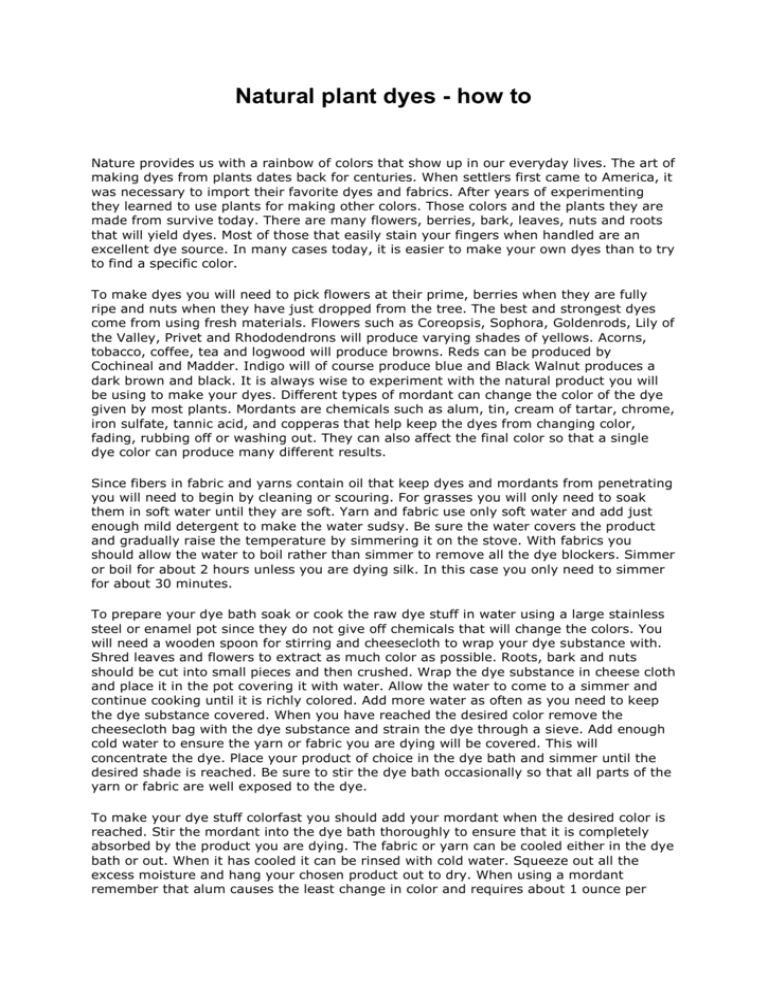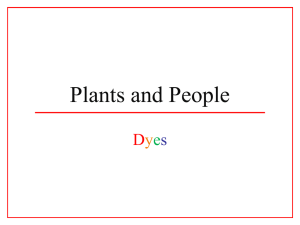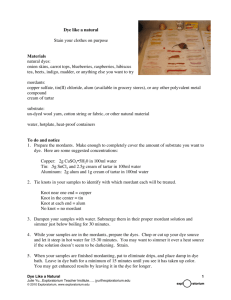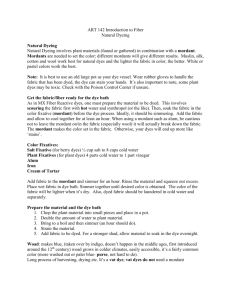Natural plant dyes
advertisement

Natural plant dyes - how to Nature provides us with a rainbow of colors that show up in our everyday lives. The art of making dyes from plants dates back for centuries. When settlers first came to America, it was necessary to import their favorite dyes and fabrics. After years of experimenting they learned to use plants for making other colors. Those colors and the plants they are made from survive today. There are many flowers, berries, bark, leaves, nuts and roots that will yield dyes. Most of those that easily stain your fingers when handled are an excellent dye source. In many cases today, it is easier to make your own dyes than to try to find a specific color. To make dyes you will need to pick flowers at their prime, berries when they are fully ripe and nuts when they have just dropped from the tree. The best and strongest dyes come from using fresh materials. Flowers such as Coreopsis, Sophora, Goldenrods, Lily of the Valley, Privet and Rhododendrons will produce varying shades of yellows. Acorns, tobacco, coffee, tea and logwood will produce browns. Reds can be produced by Cochineal and Madder. Indigo will of course produce blue and Black Walnut produces a dark brown and black. It is always wise to experiment with the natural product you will be using to make your dyes. Different types of mordant can change the color of the dye given by most plants. Mordants are chemicals such as alum, tin, cream of tartar, chrome, iron sulfate, tannic acid, and copperas that help keep the dyes from changing color, fading, rubbing off or washing out. They can also affect the final color so that a single dye color can produce many different results. Since fibers in fabric and yarns contain oil that keep dyes and mordants from penetrating you will need to begin by cleaning or scouring. For grasses you will only need to soak them in soft water until they are soft. Yarn and fabric use only soft water and add just enough mild detergent to make the water sudsy. Be sure the water covers the product and gradually raise the temperature by simmering it on the stove. With fabrics you should allow the water to boil rather than simmer to remove all the dye blockers. Simmer or boil for about 2 hours unless you are dying silk. In this case you only need to simmer for about 30 minutes. To prepare your dye bath soak or cook the raw dye stuff in water using a large stainless steel or enamel pot since they do not give off chemicals that will change the colors. You will need a wooden spoon for stirring and cheesecloth to wrap your dye substance with. Shred leaves and flowers to extract as much color as possible. Roots, bark and nuts should be cut into small pieces and then crushed. Wrap the dye substance in cheese cloth and place it in the pot covering it with water. Allow the water to come to a simmer and continue cooking until it is richly colored. Add more water as often as you need to keep the dye substance covered. When you have reached the desired color remove the cheesecloth bag with the dye substance and strain the dye through a sieve. Add enough cold water to ensure the yarn or fabric you are dying will be covered. This will concentrate the dye. Place your product of choice in the dye bath and simmer until the desired shade is reached. Be sure to stir the dye bath occasionally so that all parts of the yarn or fabric are well exposed to the dye. To make your dye stuff colorfast you should add your mordant when the desired color is reached. Stir the mordant into the dye bath thoroughly to ensure that it is completely absorbed by the product you are dying. The fabric or yarn can be cooled either in the dye bath or out. When it has cooled it can be rinsed with cold water. Squeeze out all the excess moisture and hang your chosen product out to dry. When using a mordant remember that alum causes the least change in color and requires about 1 ounce per gallon of water. Blue vitriol will sometimes color fibers green and requires 1\4 ounce per gallon of water. Chrome, or potassium dichromate, will often strengthen colors and requires about 1\8 ounce per gallon of water. Copperas or iron sulfate tends to turn fibers gray and requires 1\8 ounce per gallon of water. Tannic acid, which is derived from tea, gives fabrics the brown shades and requires 1 1\4 tablespoons per gallon of water. Tin will brighten the colors, especially reds and yellows, and requires 1 ounce per gallon of water. Most mordants can be purchased from a chemical supply house or pharmacy. Since they come in a range of purities, the chemical grade is sufficient for dying and much less expensive than the pure grades.







